Comprehensive Report on the Business Environment of Marks & Spencer
VerifiedAdded on 2021/02/20
|12
|4169
|167
Report
AI Summary
This report provides a comprehensive analysis of the business environment, focusing on Marks & Spencer. It begins by categorizing different types of business organizations (private, public, and voluntary sectors) and their purposes, with Marks & Spencer used as a case study for the private sector. The report then examines the size and scope of various organizations, including Marks & Spencer, NHS, and Oxfam. A key section explores the relationships between different departments within an organization, highlighting the interdependencies of marketing, finance, and human resources. The report also includes a PESTEL analysis to identify macro-environmental factors impacting business operations and a SWOT analysis to assess the company's internal strengths, weaknesses, opportunities, and threats. The analysis considers how internal factors relate to external macro factors, offering a holistic view of the business environment and its influence on Marks & Spencer.
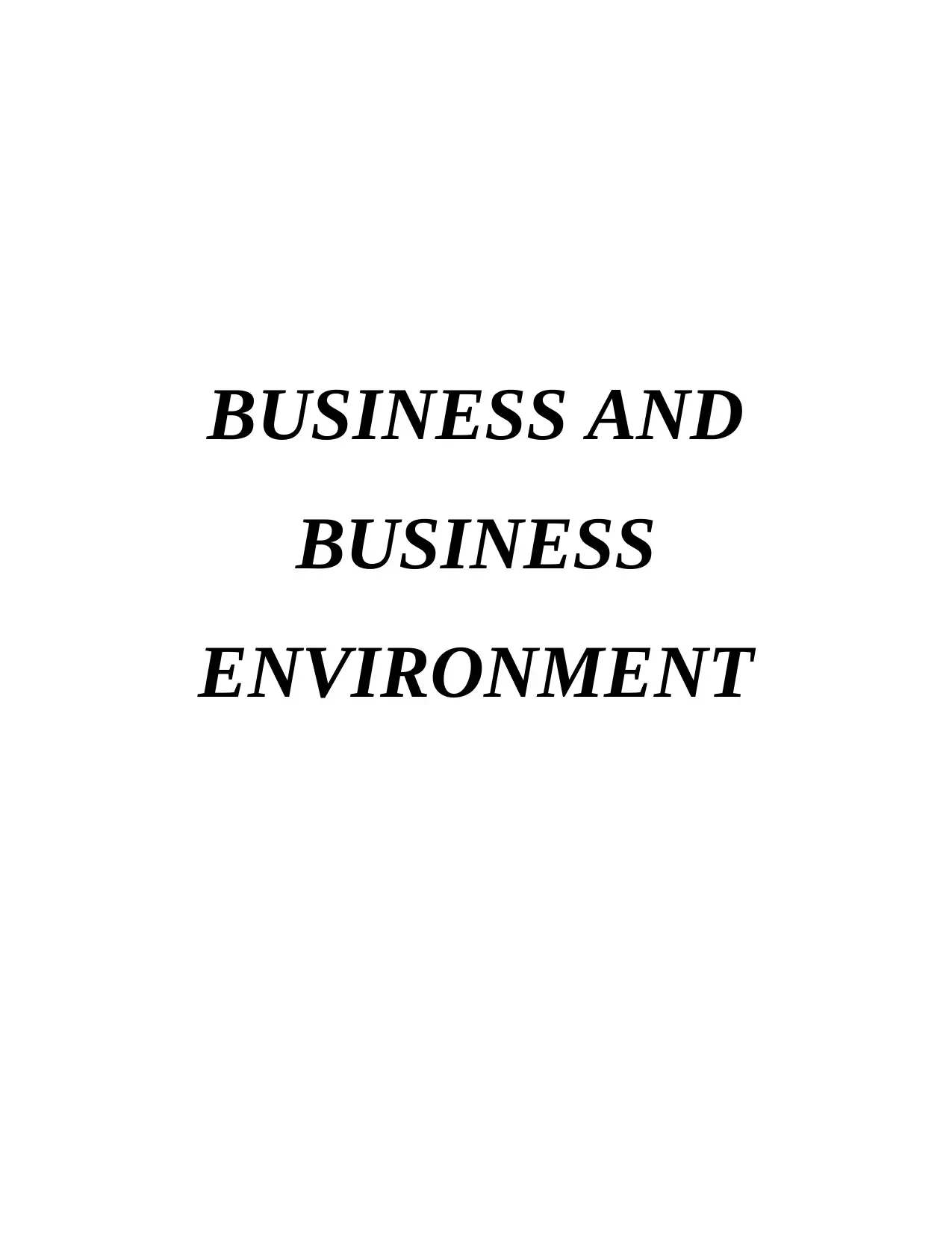
BUSINESS AND
BUSINESS
ENVIRONMENT
BUSINESS
ENVIRONMENT
Paraphrase This Document
Need a fresh take? Get an instant paraphrase of this document with our AI Paraphraser
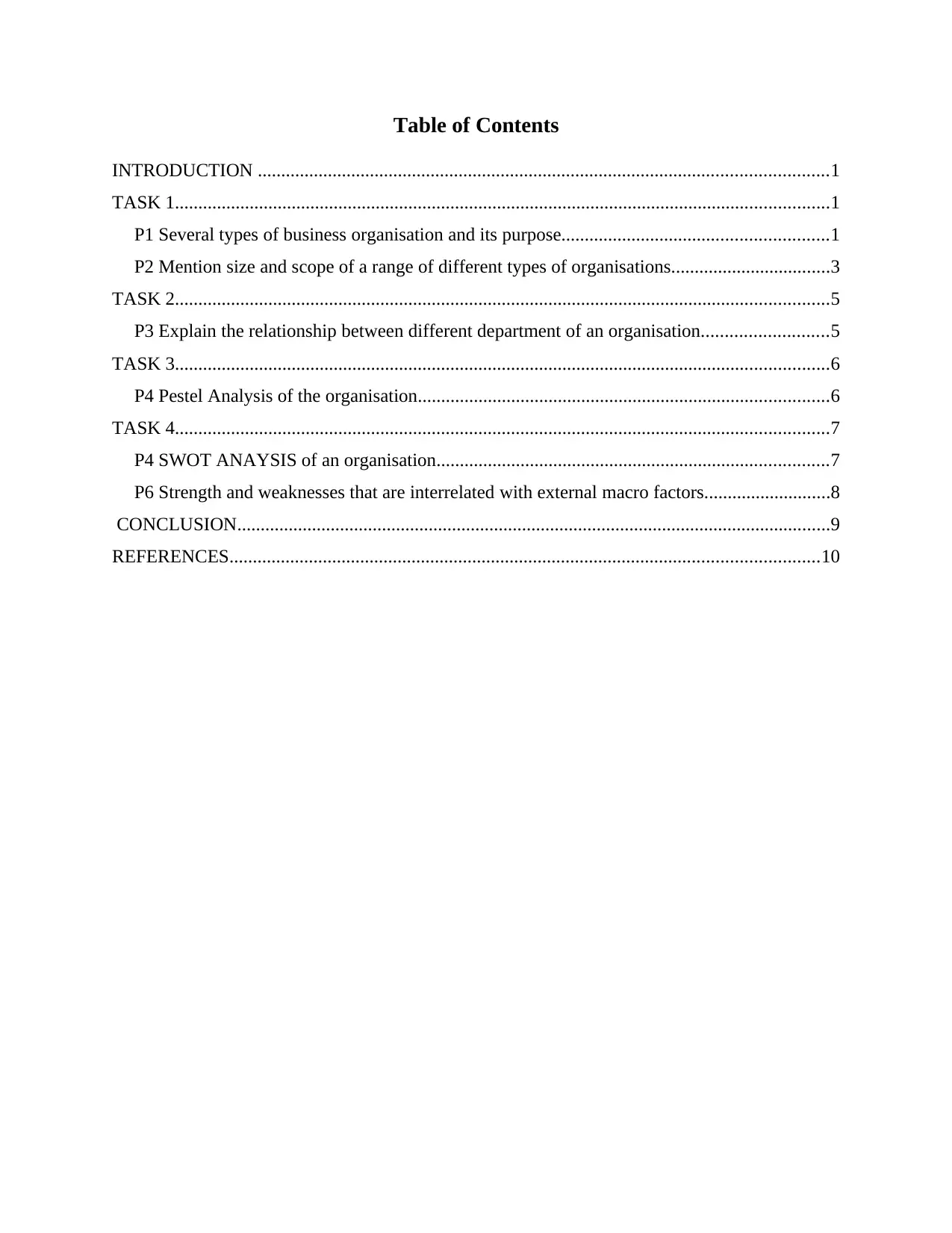
Table of Contents
INTRODUCTION ..........................................................................................................................1
TASK 1............................................................................................................................................1
P1 Several types of business organisation and its purpose.........................................................1
P2 Mention size and scope of a range of different types of organisations..................................3
TASK 2............................................................................................................................................5
P3 Explain the relationship between different department of an organisation...........................5
TASK 3............................................................................................................................................6
P4 Pestel Analysis of the organisation........................................................................................6
TASK 4............................................................................................................................................7
P4 SWOT ANAYSIS of an organisation....................................................................................7
P6 Strength and weaknesses that are interrelated with external macro factors...........................8
CONCLUSION...............................................................................................................................9
REFERENCES..............................................................................................................................10
INTRODUCTION ..........................................................................................................................1
TASK 1............................................................................................................................................1
P1 Several types of business organisation and its purpose.........................................................1
P2 Mention size and scope of a range of different types of organisations..................................3
TASK 2............................................................................................................................................5
P3 Explain the relationship between different department of an organisation...........................5
TASK 3............................................................................................................................................6
P4 Pestel Analysis of the organisation........................................................................................6
TASK 4............................................................................................................................................7
P4 SWOT ANAYSIS of an organisation....................................................................................7
P6 Strength and weaknesses that are interrelated with external macro factors...........................8
CONCLUSION...............................................................................................................................9
REFERENCES..............................................................................................................................10
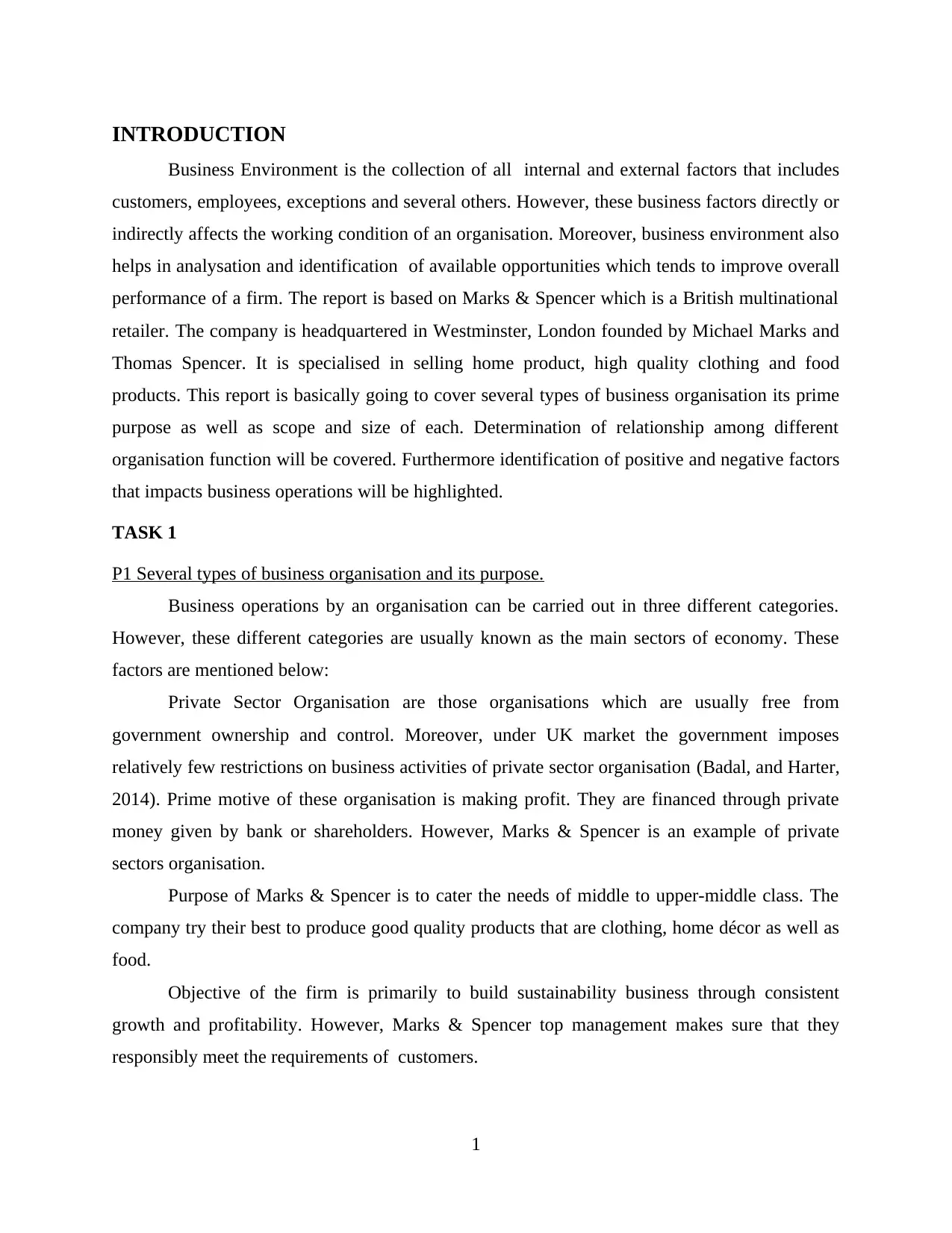
INTRODUCTION
Business Environment is the collection of all internal and external factors that includes
customers, employees, exceptions and several others. However, these business factors directly or
indirectly affects the working condition of an organisation. Moreover, business environment also
helps in analysation and identification of available opportunities which tends to improve overall
performance of a firm. The report is based on Marks & Spencer which is a British multinational
retailer. The company is headquartered in Westminster, London founded by Michael Marks and
Thomas Spencer. It is specialised in selling home product, high quality clothing and food
products. This report is basically going to cover several types of business organisation its prime
purpose as well as scope and size of each. Determination of relationship among different
organisation function will be covered. Furthermore identification of positive and negative factors
that impacts business operations will be highlighted.
TASK 1
P1 Several types of business organisation and its purpose.
Business operations by an organisation can be carried out in three different categories.
However, these different categories are usually known as the main sectors of economy. These
factors are mentioned below:
Private Sector Organisation are those organisations which are usually free from
government ownership and control. Moreover, under UK market the government imposes
relatively few restrictions on business activities of private sector organisation (Badal, and Harter,
2014). Prime motive of these organisation is making profit. They are financed through private
money given by bank or shareholders. However, Marks & Spencer is an example of private
sectors organisation.
Purpose of Marks & Spencer is to cater the needs of middle to upper-middle class. The
company try their best to produce good quality products that are clothing, home décor as well as
food.
Objective of the firm is primarily to build sustainability business through consistent
growth and profitability. However, Marks & Spencer top management makes sure that they
responsibly meet the requirements of customers.
1
Business Environment is the collection of all internal and external factors that includes
customers, employees, exceptions and several others. However, these business factors directly or
indirectly affects the working condition of an organisation. Moreover, business environment also
helps in analysation and identification of available opportunities which tends to improve overall
performance of a firm. The report is based on Marks & Spencer which is a British multinational
retailer. The company is headquartered in Westminster, London founded by Michael Marks and
Thomas Spencer. It is specialised in selling home product, high quality clothing and food
products. This report is basically going to cover several types of business organisation its prime
purpose as well as scope and size of each. Determination of relationship among different
organisation function will be covered. Furthermore identification of positive and negative factors
that impacts business operations will be highlighted.
TASK 1
P1 Several types of business organisation and its purpose.
Business operations by an organisation can be carried out in three different categories.
However, these different categories are usually known as the main sectors of economy. These
factors are mentioned below:
Private Sector Organisation are those organisations which are usually free from
government ownership and control. Moreover, under UK market the government imposes
relatively few restrictions on business activities of private sector organisation (Badal, and Harter,
2014). Prime motive of these organisation is making profit. They are financed through private
money given by bank or shareholders. However, Marks & Spencer is an example of private
sectors organisation.
Purpose of Marks & Spencer is to cater the needs of middle to upper-middle class. The
company try their best to produce good quality products that are clothing, home décor as well as
food.
Objective of the firm is primarily to build sustainability business through consistent
growth and profitability. However, Marks & Spencer top management makes sure that they
responsibly meet the requirements of customers.
1
⊘ This is a preview!⊘
Do you want full access?
Subscribe today to unlock all pages.

Trusted by 1+ million students worldwide
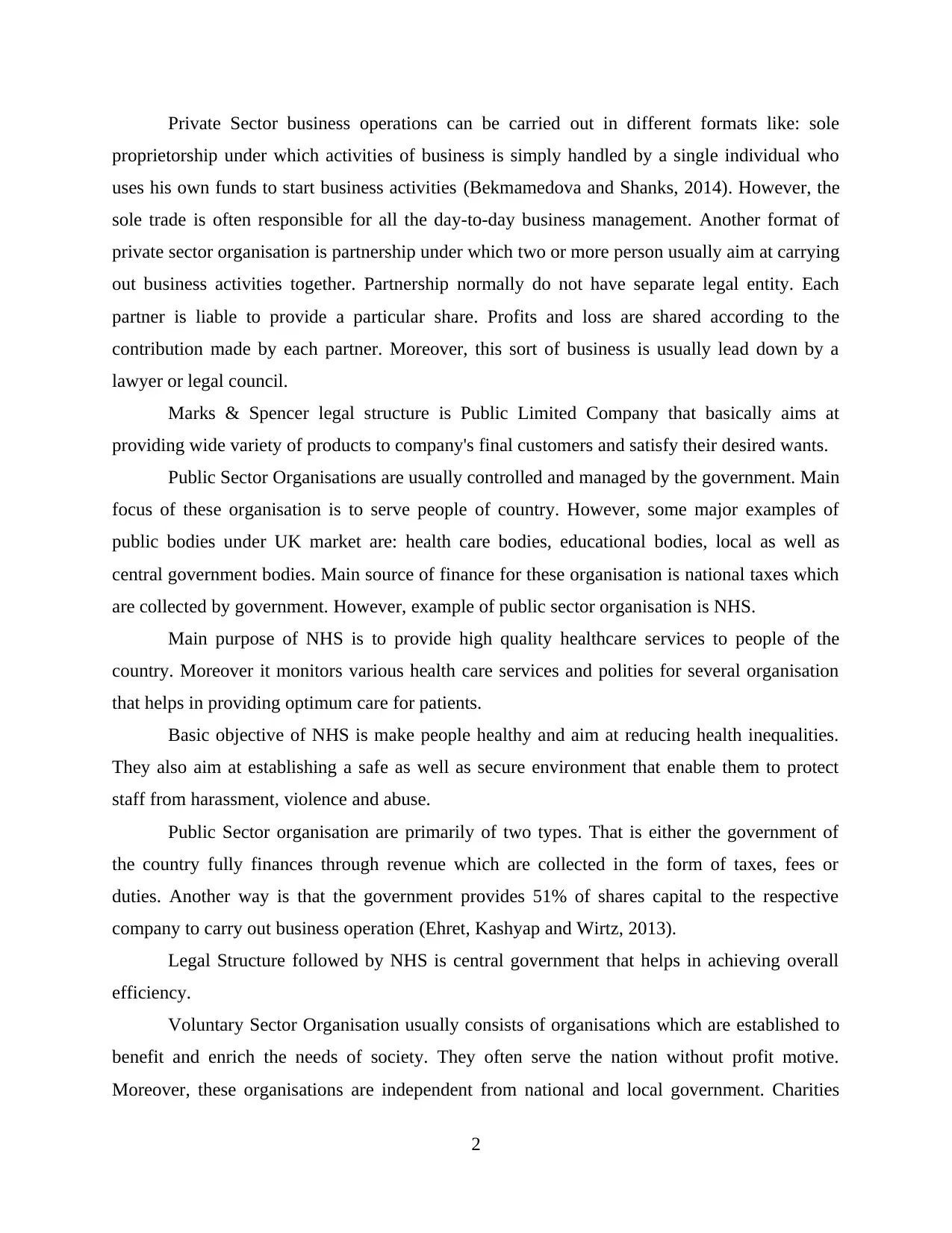
Private Sector business operations can be carried out in different formats like: sole
proprietorship under which activities of business is simply handled by a single individual who
uses his own funds to start business activities (Bekmamedova and Shanks, 2014). However, the
sole trade is often responsible for all the day-to-day business management. Another format of
private sector organisation is partnership under which two or more person usually aim at carrying
out business activities together. Partnership normally do not have separate legal entity. Each
partner is liable to provide a particular share. Profits and loss are shared according to the
contribution made by each partner. Moreover, this sort of business is usually lead down by a
lawyer or legal council.
Marks & Spencer legal structure is Public Limited Company that basically aims at
providing wide variety of products to company's final customers and satisfy their desired wants.
Public Sector Organisations are usually controlled and managed by the government. Main
focus of these organisation is to serve people of country. However, some major examples of
public bodies under UK market are: health care bodies, educational bodies, local as well as
central government bodies. Main source of finance for these organisation is national taxes which
are collected by government. However, example of public sector organisation is NHS.
Main purpose of NHS is to provide high quality healthcare services to people of the
country. Moreover it monitors various health care services and polities for several organisation
that helps in providing optimum care for patients.
Basic objective of NHS is make people healthy and aim at reducing health inequalities.
They also aim at establishing a safe as well as secure environment that enable them to protect
staff from harassment, violence and abuse.
Public Sector organisation are primarily of two types. That is either the government of
the country fully finances through revenue which are collected in the form of taxes, fees or
duties. Another way is that the government provides 51% of shares capital to the respective
company to carry out business operation (Ehret, Kashyap and Wirtz, 2013).
Legal Structure followed by NHS is central government that helps in achieving overall
efficiency.
Voluntary Sector Organisation usually consists of organisations which are established to
benefit and enrich the needs of society. They often serve the nation without profit motive.
Moreover, these organisations are independent from national and local government. Charities
2
proprietorship under which activities of business is simply handled by a single individual who
uses his own funds to start business activities (Bekmamedova and Shanks, 2014). However, the
sole trade is often responsible for all the day-to-day business management. Another format of
private sector organisation is partnership under which two or more person usually aim at carrying
out business activities together. Partnership normally do not have separate legal entity. Each
partner is liable to provide a particular share. Profits and loss are shared according to the
contribution made by each partner. Moreover, this sort of business is usually lead down by a
lawyer or legal council.
Marks & Spencer legal structure is Public Limited Company that basically aims at
providing wide variety of products to company's final customers and satisfy their desired wants.
Public Sector Organisations are usually controlled and managed by the government. Main
focus of these organisation is to serve people of country. However, some major examples of
public bodies under UK market are: health care bodies, educational bodies, local as well as
central government bodies. Main source of finance for these organisation is national taxes which
are collected by government. However, example of public sector organisation is NHS.
Main purpose of NHS is to provide high quality healthcare services to people of the
country. Moreover it monitors various health care services and polities for several organisation
that helps in providing optimum care for patients.
Basic objective of NHS is make people healthy and aim at reducing health inequalities.
They also aim at establishing a safe as well as secure environment that enable them to protect
staff from harassment, violence and abuse.
Public Sector organisation are primarily of two types. That is either the government of
the country fully finances through revenue which are collected in the form of taxes, fees or
duties. Another way is that the government provides 51% of shares capital to the respective
company to carry out business operation (Ehret, Kashyap and Wirtz, 2013).
Legal Structure followed by NHS is central government that helps in achieving overall
efficiency.
Voluntary Sector Organisation usually consists of organisations which are established to
benefit and enrich the needs of society. They often serve the nation without profit motive.
Moreover, these organisations are independent from national and local government. Charities
2
Paraphrase This Document
Need a fresh take? Get an instant paraphrase of this document with our AI Paraphraser
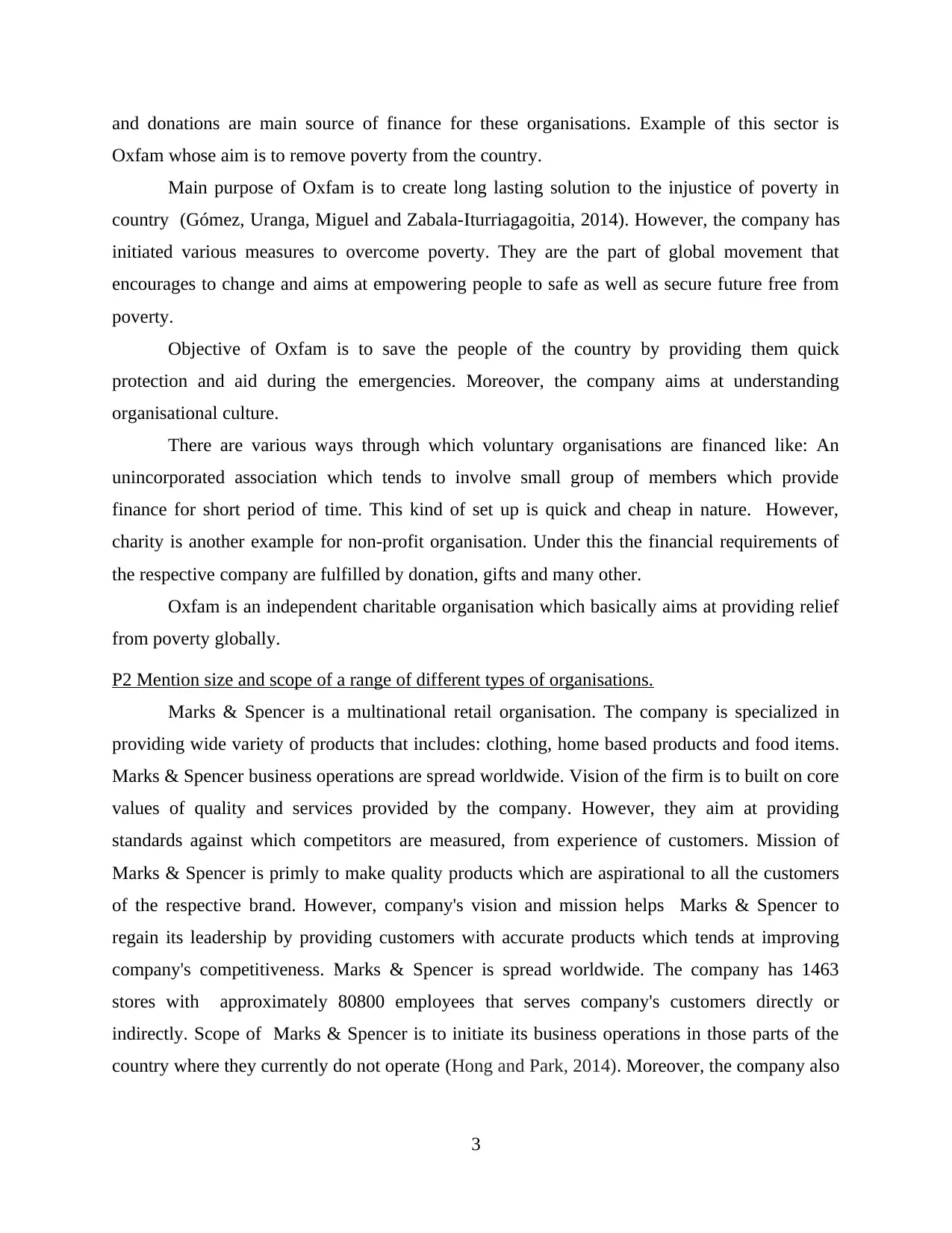
and donations are main source of finance for these organisations. Example of this sector is
Oxfam whose aim is to remove poverty from the country.
Main purpose of Oxfam is to create long lasting solution to the injustice of poverty in
country (Gómez, Uranga, Miguel and Zabala-Iturriagagoitia, 2014). However, the company has
initiated various measures to overcome poverty. They are the part of global movement that
encourages to change and aims at empowering people to safe as well as secure future free from
poverty.
Objective of Oxfam is to save the people of the country by providing them quick
protection and aid during the emergencies. Moreover, the company aims at understanding
organisational culture.
There are various ways through which voluntary organisations are financed like: An
unincorporated association which tends to involve small group of members which provide
finance for short period of time. This kind of set up is quick and cheap in nature. However,
charity is another example for non-profit organisation. Under this the financial requirements of
the respective company are fulfilled by donation, gifts and many other.
Oxfam is an independent charitable organisation which basically aims at providing relief
from poverty globally.
P2 Mention size and scope of a range of different types of organisations.
Marks & Spencer is a multinational retail organisation. The company is specialized in
providing wide variety of products that includes: clothing, home based products and food items.
Marks & Spencer business operations are spread worldwide. Vision of the firm is to built on core
values of quality and services provided by the company. However, they aim at providing
standards against which competitors are measured, from experience of customers. Mission of
Marks & Spencer is primly to make quality products which are aspirational to all the customers
of the respective brand. However, company's vision and mission helps Marks & Spencer to
regain its leadership by providing customers with accurate products which tends at improving
company's competitiveness. Marks & Spencer is spread worldwide. The company has 1463
stores with approximately 80800 employees that serves company's customers directly or
indirectly. Scope of Marks & Spencer is to initiate its business operations in those parts of the
country where they currently do not operate (Hong and Park, 2014). Moreover, the company also
3
Oxfam whose aim is to remove poverty from the country.
Main purpose of Oxfam is to create long lasting solution to the injustice of poverty in
country (Gómez, Uranga, Miguel and Zabala-Iturriagagoitia, 2014). However, the company has
initiated various measures to overcome poverty. They are the part of global movement that
encourages to change and aims at empowering people to safe as well as secure future free from
poverty.
Objective of Oxfam is to save the people of the country by providing them quick
protection and aid during the emergencies. Moreover, the company aims at understanding
organisational culture.
There are various ways through which voluntary organisations are financed like: An
unincorporated association which tends to involve small group of members which provide
finance for short period of time. This kind of set up is quick and cheap in nature. However,
charity is another example for non-profit organisation. Under this the financial requirements of
the respective company are fulfilled by donation, gifts and many other.
Oxfam is an independent charitable organisation which basically aims at providing relief
from poverty globally.
P2 Mention size and scope of a range of different types of organisations.
Marks & Spencer is a multinational retail organisation. The company is specialized in
providing wide variety of products that includes: clothing, home based products and food items.
Marks & Spencer business operations are spread worldwide. Vision of the firm is to built on core
values of quality and services provided by the company. However, they aim at providing
standards against which competitors are measured, from experience of customers. Mission of
Marks & Spencer is primly to make quality products which are aspirational to all the customers
of the respective brand. However, company's vision and mission helps Marks & Spencer to
regain its leadership by providing customers with accurate products which tends at improving
company's competitiveness. Marks & Spencer is spread worldwide. The company has 1463
stores with approximately 80800 employees that serves company's customers directly or
indirectly. Scope of Marks & Spencer is to initiate its business operations in those parts of the
country where they currently do not operate (Hong and Park, 2014). Moreover, the company also
3
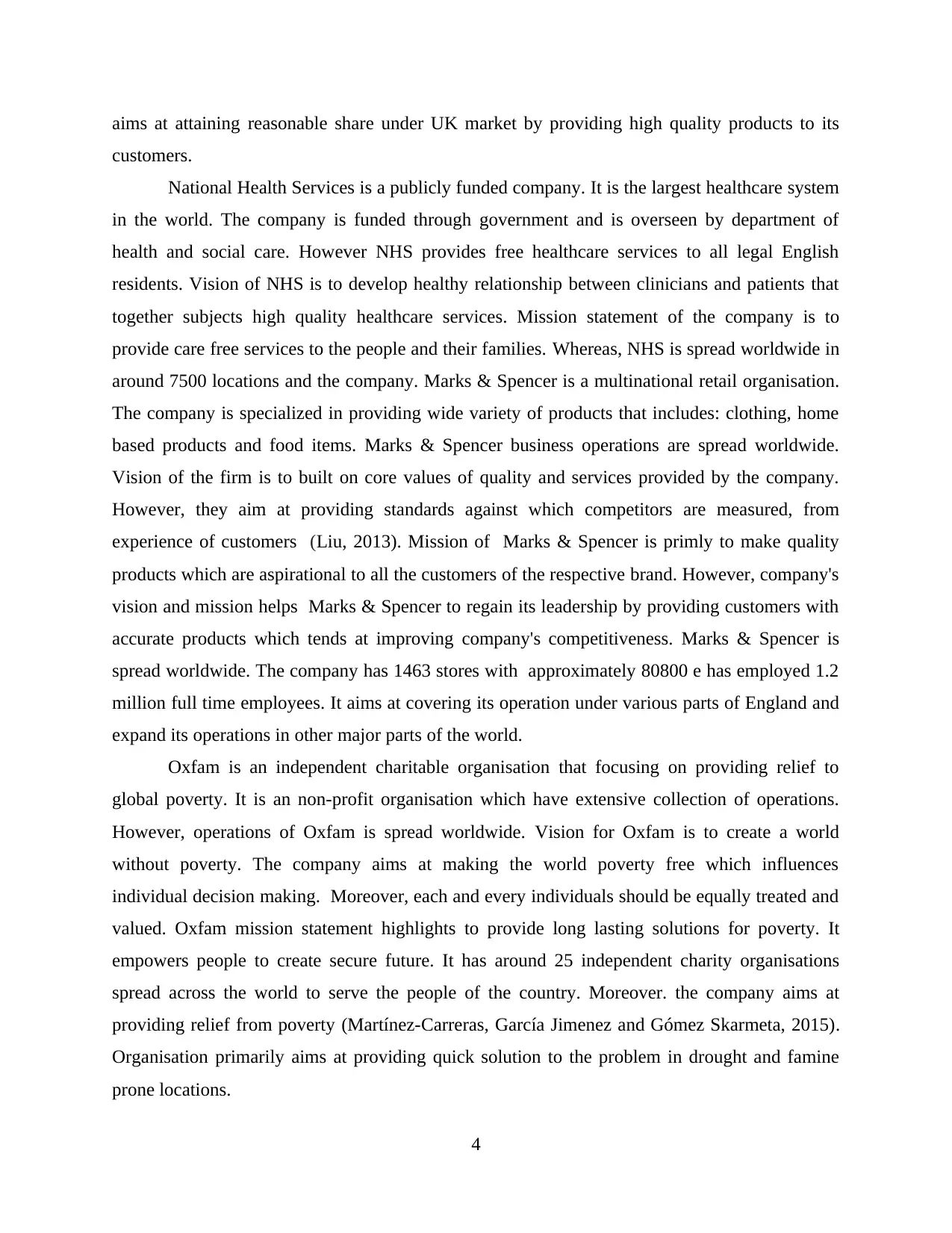
aims at attaining reasonable share under UK market by providing high quality products to its
customers.
National Health Services is a publicly funded company. It is the largest healthcare system
in the world. The company is funded through government and is overseen by department of
health and social care. However NHS provides free healthcare services to all legal English
residents. Vision of NHS is to develop healthy relationship between clinicians and patients that
together subjects high quality healthcare services. Mission statement of the company is to
provide care free services to the people and their families. Whereas, NHS is spread worldwide in
around 7500 locations and the company. Marks & Spencer is a multinational retail organisation.
The company is specialized in providing wide variety of products that includes: clothing, home
based products and food items. Marks & Spencer business operations are spread worldwide.
Vision of the firm is to built on core values of quality and services provided by the company.
However, they aim at providing standards against which competitors are measured, from
experience of customers (Liu, 2013). Mission of Marks & Spencer is primly to make quality
products which are aspirational to all the customers of the respective brand. However, company's
vision and mission helps Marks & Spencer to regain its leadership by providing customers with
accurate products which tends at improving company's competitiveness. Marks & Spencer is
spread worldwide. The company has 1463 stores with approximately 80800 e has employed 1.2
million full time employees. It aims at covering its operation under various parts of England and
expand its operations in other major parts of the world.
Oxfam is an independent charitable organisation that focusing on providing relief to
global poverty. It is an non-profit organisation which have extensive collection of operations.
However, operations of Oxfam is spread worldwide. Vision for Oxfam is to create a world
without poverty. The company aims at making the world poverty free which influences
individual decision making. Moreover, each and every individuals should be equally treated and
valued. Oxfam mission statement highlights to provide long lasting solutions for poverty. It
empowers people to create secure future. It has around 25 independent charity organisations
spread across the world to serve the people of the country. Moreover. the company aims at
providing relief from poverty (Martínez-Carreras, García Jimenez and Gómez Skarmeta, 2015).
Organisation primarily aims at providing quick solution to the problem in drought and famine
prone locations.
4
customers.
National Health Services is a publicly funded company. It is the largest healthcare system
in the world. The company is funded through government and is overseen by department of
health and social care. However NHS provides free healthcare services to all legal English
residents. Vision of NHS is to develop healthy relationship between clinicians and patients that
together subjects high quality healthcare services. Mission statement of the company is to
provide care free services to the people and their families. Whereas, NHS is spread worldwide in
around 7500 locations and the company. Marks & Spencer is a multinational retail organisation.
The company is specialized in providing wide variety of products that includes: clothing, home
based products and food items. Marks & Spencer business operations are spread worldwide.
Vision of the firm is to built on core values of quality and services provided by the company.
However, they aim at providing standards against which competitors are measured, from
experience of customers (Liu, 2013). Mission of Marks & Spencer is primly to make quality
products which are aspirational to all the customers of the respective brand. However, company's
vision and mission helps Marks & Spencer to regain its leadership by providing customers with
accurate products which tends at improving company's competitiveness. Marks & Spencer is
spread worldwide. The company has 1463 stores with approximately 80800 e has employed 1.2
million full time employees. It aims at covering its operation under various parts of England and
expand its operations in other major parts of the world.
Oxfam is an independent charitable organisation that focusing on providing relief to
global poverty. It is an non-profit organisation which have extensive collection of operations.
However, operations of Oxfam is spread worldwide. Vision for Oxfam is to create a world
without poverty. The company aims at making the world poverty free which influences
individual decision making. Moreover, each and every individuals should be equally treated and
valued. Oxfam mission statement highlights to provide long lasting solutions for poverty. It
empowers people to create secure future. It has around 25 independent charity organisations
spread across the world to serve the people of the country. Moreover. the company aims at
providing relief from poverty (Martínez-Carreras, García Jimenez and Gómez Skarmeta, 2015).
Organisation primarily aims at providing quick solution to the problem in drought and famine
prone locations.
4
⊘ This is a preview!⊘
Do you want full access?
Subscribe today to unlock all pages.

Trusted by 1+ million students worldwide
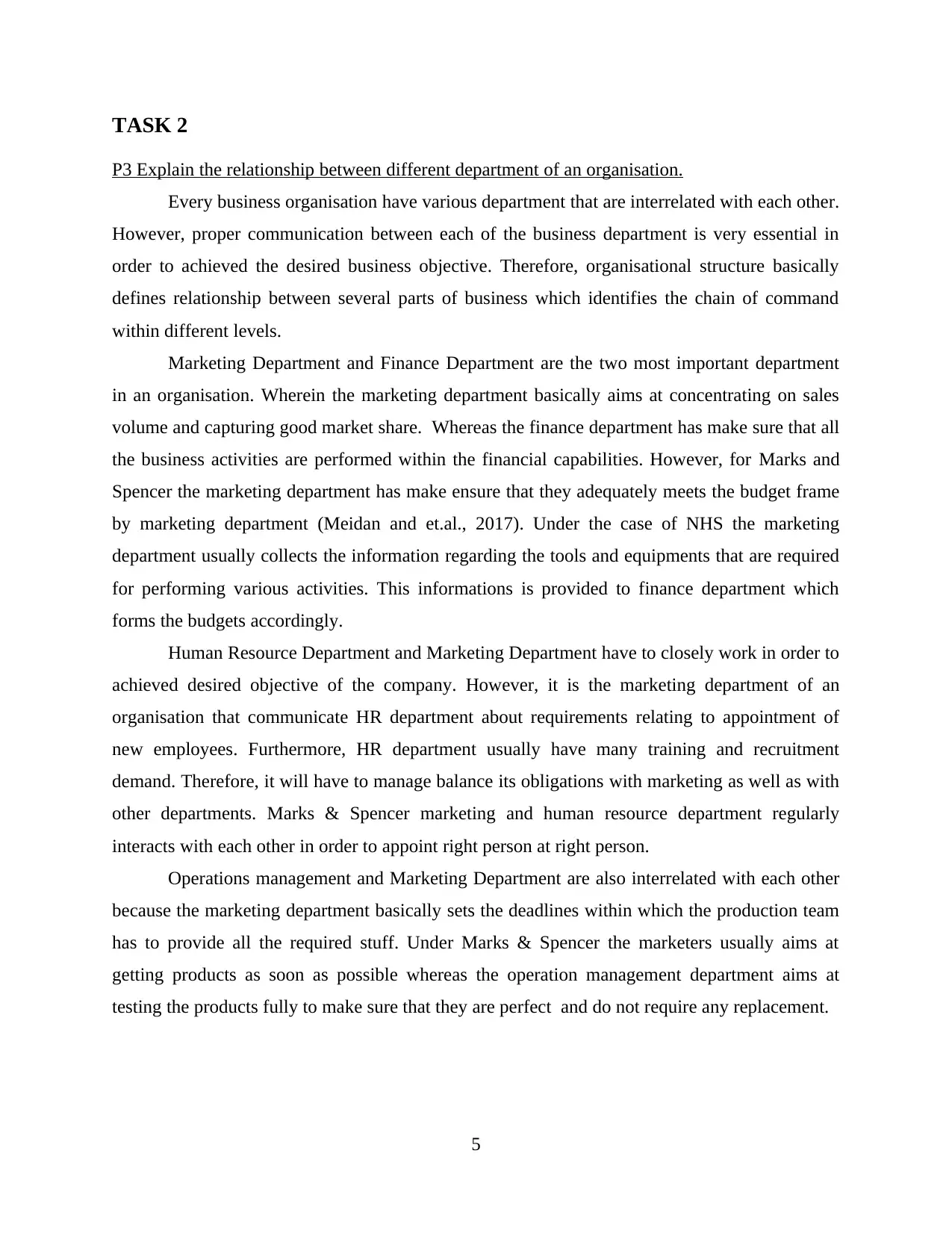
TASK 2
P3 Explain the relationship between different department of an organisation.
Every business organisation have various department that are interrelated with each other.
However, proper communication between each of the business department is very essential in
order to achieved the desired business objective. Therefore, organisational structure basically
defines relationship between several parts of business which identifies the chain of command
within different levels.
Marketing Department and Finance Department are the two most important department
in an organisation. Wherein the marketing department basically aims at concentrating on sales
volume and capturing good market share. Whereas the finance department has make sure that all
the business activities are performed within the financial capabilities. However, for Marks and
Spencer the marketing department has make ensure that they adequately meets the budget frame
by marketing department (Meidan and et.al., 2017). Under the case of NHS the marketing
department usually collects the information regarding the tools and equipments that are required
for performing various activities. This informations is provided to finance department which
forms the budgets accordingly.
Human Resource Department and Marketing Department have to closely work in order to
achieved desired objective of the company. However, it is the marketing department of an
organisation that communicate HR department about requirements relating to appointment of
new employees. Furthermore, HR department usually have many training and recruitment
demand. Therefore, it will have to manage balance its obligations with marketing as well as with
other departments. Marks & Spencer marketing and human resource department regularly
interacts with each other in order to appoint right person at right person.
Operations management and Marketing Department are also interrelated with each other
because the marketing department basically sets the deadlines within which the production team
has to provide all the required stuff. Under Marks & Spencer the marketers usually aims at
getting products as soon as possible whereas the operation management department aims at
testing the products fully to make sure that they are perfect and do not require any replacement.
5
P3 Explain the relationship between different department of an organisation.
Every business organisation have various department that are interrelated with each other.
However, proper communication between each of the business department is very essential in
order to achieved the desired business objective. Therefore, organisational structure basically
defines relationship between several parts of business which identifies the chain of command
within different levels.
Marketing Department and Finance Department are the two most important department
in an organisation. Wherein the marketing department basically aims at concentrating on sales
volume and capturing good market share. Whereas the finance department has make sure that all
the business activities are performed within the financial capabilities. However, for Marks and
Spencer the marketing department has make ensure that they adequately meets the budget frame
by marketing department (Meidan and et.al., 2017). Under the case of NHS the marketing
department usually collects the information regarding the tools and equipments that are required
for performing various activities. This informations is provided to finance department which
forms the budgets accordingly.
Human Resource Department and Marketing Department have to closely work in order to
achieved desired objective of the company. However, it is the marketing department of an
organisation that communicate HR department about requirements relating to appointment of
new employees. Furthermore, HR department usually have many training and recruitment
demand. Therefore, it will have to manage balance its obligations with marketing as well as with
other departments. Marks & Spencer marketing and human resource department regularly
interacts with each other in order to appoint right person at right person.
Operations management and Marketing Department are also interrelated with each other
because the marketing department basically sets the deadlines within which the production team
has to provide all the required stuff. Under Marks & Spencer the marketers usually aims at
getting products as soon as possible whereas the operation management department aims at
testing the products fully to make sure that they are perfect and do not require any replacement.
5
Paraphrase This Document
Need a fresh take? Get an instant paraphrase of this document with our AI Paraphraser
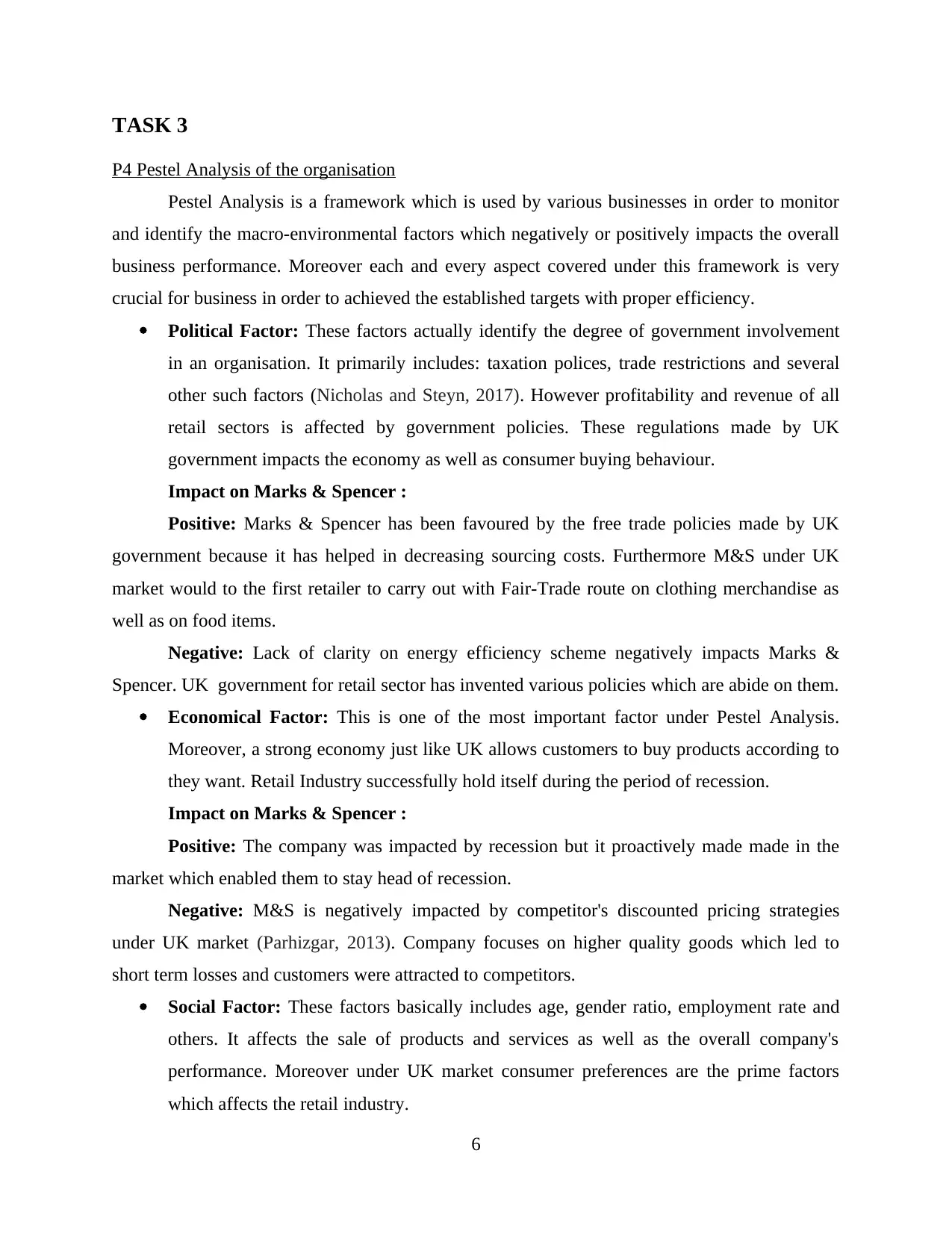
TASK 3
P4 Pestel Analysis of the organisation
Pestel Analysis is a framework which is used by various businesses in order to monitor
and identify the macro-environmental factors which negatively or positively impacts the overall
business performance. Moreover each and every aspect covered under this framework is very
crucial for business in order to achieved the established targets with proper efficiency.
Political Factor: These factors actually identify the degree of government involvement
in an organisation. It primarily includes: taxation polices, trade restrictions and several
other such factors (Nicholas and Steyn, 2017). However profitability and revenue of all
retail sectors is affected by government policies. These regulations made by UK
government impacts the economy as well as consumer buying behaviour.
Impact on Marks & Spencer :
Positive: Marks & Spencer has been favoured by the free trade policies made by UK
government because it has helped in decreasing sourcing costs. Furthermore M&S under UK
market would to the first retailer to carry out with Fair-Trade route on clothing merchandise as
well as on food items.
Negative: Lack of clarity on energy efficiency scheme negatively impacts Marks &
Spencer. UK government for retail sector has invented various policies which are abide on them.
Economical Factor: This is one of the most important factor under Pestel Analysis.
Moreover, a strong economy just like UK allows customers to buy products according to
they want. Retail Industry successfully hold itself during the period of recession.
Impact on Marks & Spencer :
Positive: The company was impacted by recession but it proactively made made in the
market which enabled them to stay head of recession.
Negative: M&S is negatively impacted by competitor's discounted pricing strategies
under UK market (Parhizgar, 2013). Company focuses on higher quality goods which led to
short term losses and customers were attracted to competitors.
Social Factor: These factors basically includes age, gender ratio, employment rate and
others. It affects the sale of products and services as well as the overall company's
performance. Moreover under UK market consumer preferences are the prime factors
which affects the retail industry.
6
P4 Pestel Analysis of the organisation
Pestel Analysis is a framework which is used by various businesses in order to monitor
and identify the macro-environmental factors which negatively or positively impacts the overall
business performance. Moreover each and every aspect covered under this framework is very
crucial for business in order to achieved the established targets with proper efficiency.
Political Factor: These factors actually identify the degree of government involvement
in an organisation. It primarily includes: taxation polices, trade restrictions and several
other such factors (Nicholas and Steyn, 2017). However profitability and revenue of all
retail sectors is affected by government policies. These regulations made by UK
government impacts the economy as well as consumer buying behaviour.
Impact on Marks & Spencer :
Positive: Marks & Spencer has been favoured by the free trade policies made by UK
government because it has helped in decreasing sourcing costs. Furthermore M&S under UK
market would to the first retailer to carry out with Fair-Trade route on clothing merchandise as
well as on food items.
Negative: Lack of clarity on energy efficiency scheme negatively impacts Marks &
Spencer. UK government for retail sector has invented various policies which are abide on them.
Economical Factor: This is one of the most important factor under Pestel Analysis.
Moreover, a strong economy just like UK allows customers to buy products according to
they want. Retail Industry successfully hold itself during the period of recession.
Impact on Marks & Spencer :
Positive: The company was impacted by recession but it proactively made made in the
market which enabled them to stay head of recession.
Negative: M&S is negatively impacted by competitor's discounted pricing strategies
under UK market (Parhizgar, 2013). Company focuses on higher quality goods which led to
short term losses and customers were attracted to competitors.
Social Factor: These factors basically includes age, gender ratio, employment rate and
others. It affects the sale of products and services as well as the overall company's
performance. Moreover under UK market consumer preferences are the prime factors
which affects the retail industry.
6
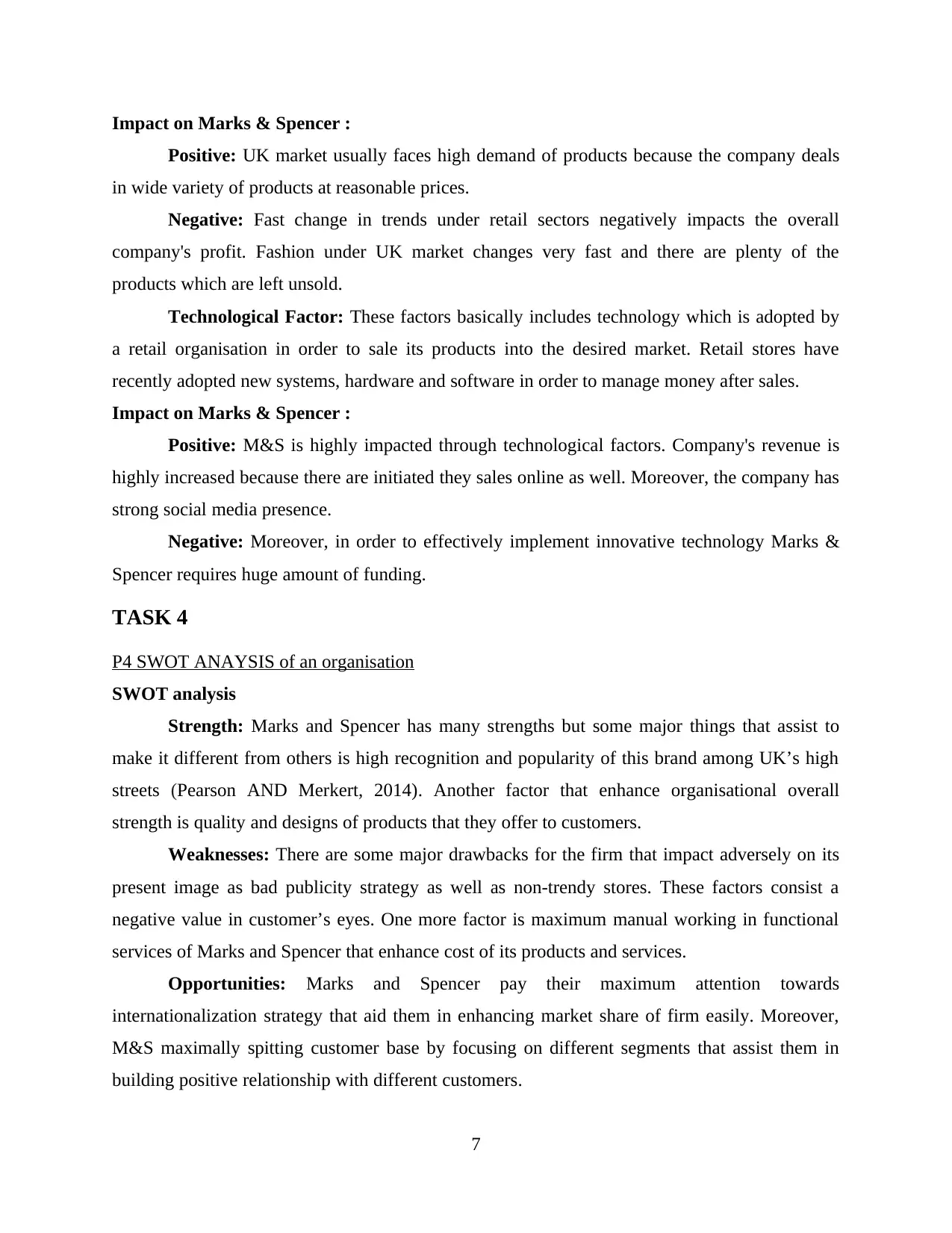
Impact on Marks & Spencer :
Positive: UK market usually faces high demand of products because the company deals
in wide variety of products at reasonable prices.
Negative: Fast change in trends under retail sectors negatively impacts the overall
company's profit. Fashion under UK market changes very fast and there are plenty of the
products which are left unsold.
Technological Factor: These factors basically includes technology which is adopted by
a retail organisation in order to sale its products into the desired market. Retail stores have
recently adopted new systems, hardware and software in order to manage money after sales.
Impact on Marks & Spencer :
Positive: M&S is highly impacted through technological factors. Company's revenue is
highly increased because there are initiated they sales online as well. Moreover, the company has
strong social media presence.
Negative: Moreover, in order to effectively implement innovative technology Marks &
Spencer requires huge amount of funding.
TASK 4
P4 SWOT ANAYSIS of an organisation
SWOT analysis
Strength: Marks and Spencer has many strengths but some major things that assist to
make it different from others is high recognition and popularity of this brand among UK’s high
streets (Pearson AND Merkert, 2014). Another factor that enhance organisational overall
strength is quality and designs of products that they offer to customers.
Weaknesses: There are some major drawbacks for the firm that impact adversely on its
present image as bad publicity strategy as well as non-trendy stores. These factors consist a
negative value in customer’s eyes. One more factor is maximum manual working in functional
services of Marks and Spencer that enhance cost of its products and services.
Opportunities: Marks and Spencer pay their maximum attention towards
internationalization strategy that aid them in enhancing market share of firm easily. Moreover,
M&S maximally spitting customer base by focusing on different segments that assist them in
building positive relationship with different customers.
7
Positive: UK market usually faces high demand of products because the company deals
in wide variety of products at reasonable prices.
Negative: Fast change in trends under retail sectors negatively impacts the overall
company's profit. Fashion under UK market changes very fast and there are plenty of the
products which are left unsold.
Technological Factor: These factors basically includes technology which is adopted by
a retail organisation in order to sale its products into the desired market. Retail stores have
recently adopted new systems, hardware and software in order to manage money after sales.
Impact on Marks & Spencer :
Positive: M&S is highly impacted through technological factors. Company's revenue is
highly increased because there are initiated they sales online as well. Moreover, the company has
strong social media presence.
Negative: Moreover, in order to effectively implement innovative technology Marks &
Spencer requires huge amount of funding.
TASK 4
P4 SWOT ANAYSIS of an organisation
SWOT analysis
Strength: Marks and Spencer has many strengths but some major things that assist to
make it different from others is high recognition and popularity of this brand among UK’s high
streets (Pearson AND Merkert, 2014). Another factor that enhance organisational overall
strength is quality and designs of products that they offer to customers.
Weaknesses: There are some major drawbacks for the firm that impact adversely on its
present image as bad publicity strategy as well as non-trendy stores. These factors consist a
negative value in customer’s eyes. One more factor is maximum manual working in functional
services of Marks and Spencer that enhance cost of its products and services.
Opportunities: Marks and Spencer pay their maximum attention towards
internationalization strategy that aid them in enhancing market share of firm easily. Moreover,
M&S maximally spitting customer base by focusing on different segments that assist them in
building positive relationship with different customers.
7
⊘ This is a preview!⊘
Do you want full access?
Subscribe today to unlock all pages.

Trusted by 1+ million students worldwide
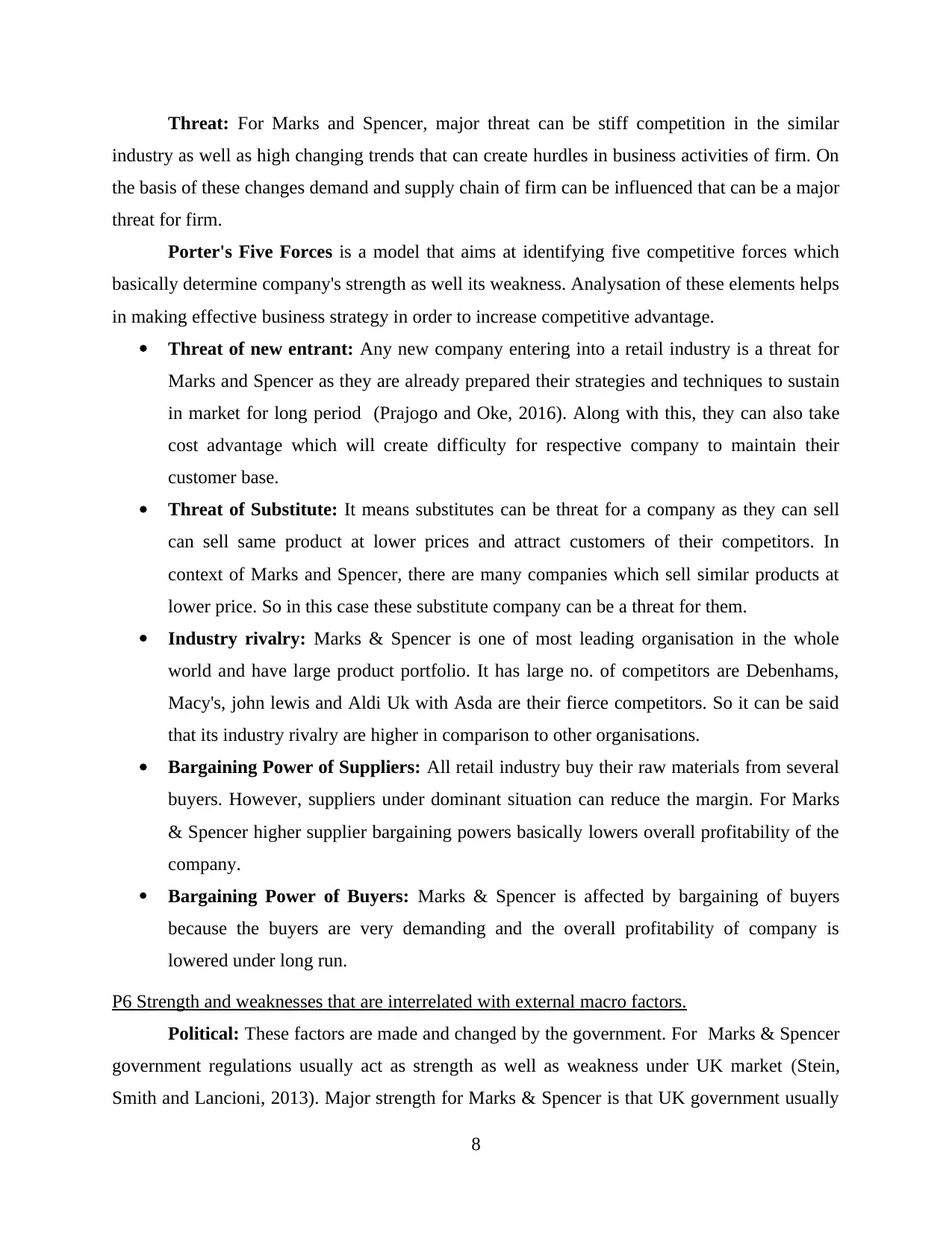
Threat: For Marks and Spencer, major threat can be stiff competition in the similar
industry as well as high changing trends that can create hurdles in business activities of firm. On
the basis of these changes demand and supply chain of firm can be influenced that can be a major
threat for firm.
Porter's Five Forces is a model that aims at identifying five competitive forces which
basically determine company's strength as well its weakness. Analysation of these elements helps
in making effective business strategy in order to increase competitive advantage.
Threat of new entrant: Any new company entering into a retail industry is a threat for
Marks and Spencer as they are already prepared their strategies and techniques to sustain
in market for long period (Prajogo and Oke, 2016). Along with this, they can also take
cost advantage which will create difficulty for respective company to maintain their
customer base.
Threat of Substitute: It means substitutes can be threat for a company as they can sell
can sell same product at lower prices and attract customers of their competitors. In
context of Marks and Spencer, there are many companies which sell similar products at
lower price. So in this case these substitute company can be a threat for them.
Industry rivalry: Marks & Spencer is one of most leading organisation in the whole
world and have large product portfolio. It has large no. of competitors are Debenhams,
Macy's, john lewis and Aldi Uk with Asda are their fierce competitors. So it can be said
that its industry rivalry are higher in comparison to other organisations.
Bargaining Power of Suppliers: All retail industry buy their raw materials from several
buyers. However, suppliers under dominant situation can reduce the margin. For Marks
& Spencer higher supplier bargaining powers basically lowers overall profitability of the
company.
Bargaining Power of Buyers: Marks & Spencer is affected by bargaining of buyers
because the buyers are very demanding and the overall profitability of company is
lowered under long run.
P6 Strength and weaknesses that are interrelated with external macro factors.
Political: These factors are made and changed by the government. For Marks & Spencer
government regulations usually act as strength as well as weakness under UK market (Stein,
Smith and Lancioni, 2013). Major strength for Marks & Spencer is that UK government usually
8
industry as well as high changing trends that can create hurdles in business activities of firm. On
the basis of these changes demand and supply chain of firm can be influenced that can be a major
threat for firm.
Porter's Five Forces is a model that aims at identifying five competitive forces which
basically determine company's strength as well its weakness. Analysation of these elements helps
in making effective business strategy in order to increase competitive advantage.
Threat of new entrant: Any new company entering into a retail industry is a threat for
Marks and Spencer as they are already prepared their strategies and techniques to sustain
in market for long period (Prajogo and Oke, 2016). Along with this, they can also take
cost advantage which will create difficulty for respective company to maintain their
customer base.
Threat of Substitute: It means substitutes can be threat for a company as they can sell
can sell same product at lower prices and attract customers of their competitors. In
context of Marks and Spencer, there are many companies which sell similar products at
lower price. So in this case these substitute company can be a threat for them.
Industry rivalry: Marks & Spencer is one of most leading organisation in the whole
world and have large product portfolio. It has large no. of competitors are Debenhams,
Macy's, john lewis and Aldi Uk with Asda are their fierce competitors. So it can be said
that its industry rivalry are higher in comparison to other organisations.
Bargaining Power of Suppliers: All retail industry buy their raw materials from several
buyers. However, suppliers under dominant situation can reduce the margin. For Marks
& Spencer higher supplier bargaining powers basically lowers overall profitability of the
company.
Bargaining Power of Buyers: Marks & Spencer is affected by bargaining of buyers
because the buyers are very demanding and the overall profitability of company is
lowered under long run.
P6 Strength and weaknesses that are interrelated with external macro factors.
Political: These factors are made and changed by the government. For Marks & Spencer
government regulations usually act as strength as well as weakness under UK market (Stein,
Smith and Lancioni, 2013). Major strength for Marks & Spencer is that UK government usually
8
Paraphrase This Document
Need a fresh take? Get an instant paraphrase of this document with our AI Paraphraser
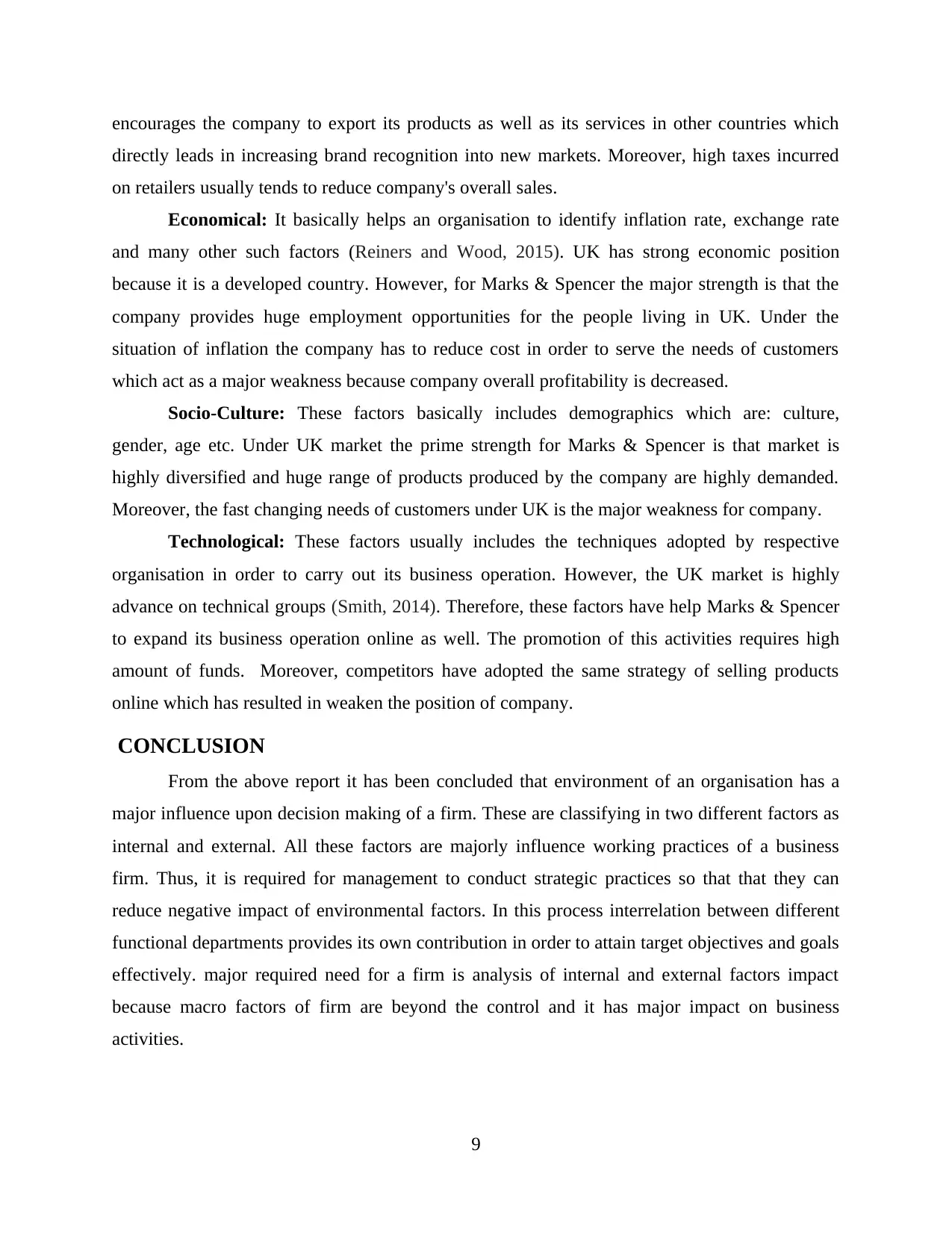
encourages the company to export its products as well as its services in other countries which
directly leads in increasing brand recognition into new markets. Moreover, high taxes incurred
on retailers usually tends to reduce company's overall sales.
Economical: It basically helps an organisation to identify inflation rate, exchange rate
and many other such factors (Reiners and Wood, 2015). UK has strong economic position
because it is a developed country. However, for Marks & Spencer the major strength is that the
company provides huge employment opportunities for the people living in UK. Under the
situation of inflation the company has to reduce cost in order to serve the needs of customers
which act as a major weakness because company overall profitability is decreased.
Socio-Culture: These factors basically includes demographics which are: culture,
gender, age etc. Under UK market the prime strength for Marks & Spencer is that market is
highly diversified and huge range of products produced by the company are highly demanded.
Moreover, the fast changing needs of customers under UK is the major weakness for company.
Technological: These factors usually includes the techniques adopted by respective
organisation in order to carry out its business operation. However, the UK market is highly
advance on technical groups (Smith, 2014). Therefore, these factors have help Marks & Spencer
to expand its business operation online as well. The promotion of this activities requires high
amount of funds. Moreover, competitors have adopted the same strategy of selling products
online which has resulted in weaken the position of company.
CONCLUSION
From the above report it has been concluded that environment of an organisation has a
major influence upon decision making of a firm. These are classifying in two different factors as
internal and external. All these factors are majorly influence working practices of a business
firm. Thus, it is required for management to conduct strategic practices so that that they can
reduce negative impact of environmental factors. In this process interrelation between different
functional departments provides its own contribution in order to attain target objectives and goals
effectively. major required need for a firm is analysis of internal and external factors impact
because macro factors of firm are beyond the control and it has major impact on business
activities.
9
directly leads in increasing brand recognition into new markets. Moreover, high taxes incurred
on retailers usually tends to reduce company's overall sales.
Economical: It basically helps an organisation to identify inflation rate, exchange rate
and many other such factors (Reiners and Wood, 2015). UK has strong economic position
because it is a developed country. However, for Marks & Spencer the major strength is that the
company provides huge employment opportunities for the people living in UK. Under the
situation of inflation the company has to reduce cost in order to serve the needs of customers
which act as a major weakness because company overall profitability is decreased.
Socio-Culture: These factors basically includes demographics which are: culture,
gender, age etc. Under UK market the prime strength for Marks & Spencer is that market is
highly diversified and huge range of products produced by the company are highly demanded.
Moreover, the fast changing needs of customers under UK is the major weakness for company.
Technological: These factors usually includes the techniques adopted by respective
organisation in order to carry out its business operation. However, the UK market is highly
advance on technical groups (Smith, 2014). Therefore, these factors have help Marks & Spencer
to expand its business operation online as well. The promotion of this activities requires high
amount of funds. Moreover, competitors have adopted the same strategy of selling products
online which has resulted in weaken the position of company.
CONCLUSION
From the above report it has been concluded that environment of an organisation has a
major influence upon decision making of a firm. These are classifying in two different factors as
internal and external. All these factors are majorly influence working practices of a business
firm. Thus, it is required for management to conduct strategic practices so that that they can
reduce negative impact of environmental factors. In this process interrelation between different
functional departments provides its own contribution in order to attain target objectives and goals
effectively. major required need for a firm is analysis of internal and external factors impact
because macro factors of firm are beyond the control and it has major impact on business
activities.
9
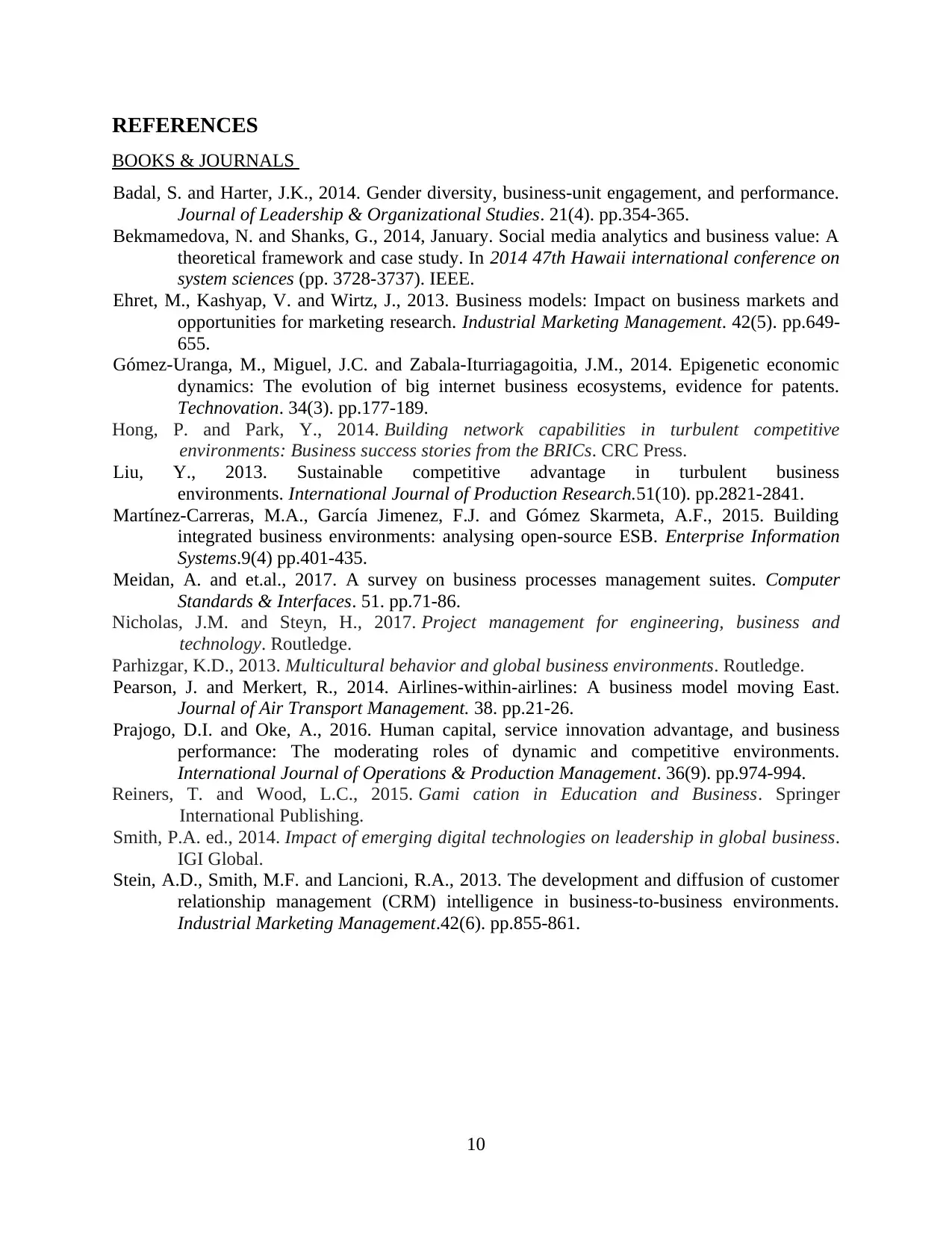
REFERENCES
BOOKS & JOURNALS
Badal, S. and Harter, J.K., 2014. Gender diversity, business-unit engagement, and performance.
Journal of Leadership & Organizational Studies. 21(4). pp.354-365.
Bekmamedova, N. and Shanks, G., 2014, January. Social media analytics and business value: A
theoretical framework and case study. In 2014 47th Hawaii international conference on
system sciences (pp. 3728-3737). IEEE.
Ehret, M., Kashyap, V. and Wirtz, J., 2013. Business models: Impact on business markets and
opportunities for marketing research. Industrial Marketing Management. 42(5). pp.649-
655.
Gómez-Uranga, M., Miguel, J.C. and Zabala-Iturriagagoitia, J.M., 2014. Epigenetic economic
dynamics: The evolution of big internet business ecosystems, evidence for patents.
Technovation. 34(3). pp.177-189.
Hong, P. and Park, Y., 2014. Building network capabilities in turbulent competitive
environments: Business success stories from the BRICs. CRC Press.
Liu, Y., 2013. Sustainable competitive advantage in turbulent business
environments. International Journal of Production Research.51(10). pp.2821-2841.
Martínez-Carreras, M.A., García Jimenez, F.J. and Gómez Skarmeta, A.F., 2015. Building
integrated business environments: analysing open-source ESB. Enterprise Information
Systems.9(4) pp.401-435.
Meidan, A. and et.al., 2017. A survey on business processes management suites. Computer
Standards & Interfaces. 51. pp.71-86.
Nicholas, J.M. and Steyn, H., 2017. Project management for engineering, business and
technology. Routledge.
Parhizgar, K.D., 2013. Multicultural behavior and global business environments. Routledge.
Pearson, J. and Merkert, R., 2014. Airlines-within-airlines: A business model moving East.
Journal of Air Transport Management. 38. pp.21-26.
Prajogo, D.I. and Oke, A., 2016. Human capital, service innovation advantage, and business
performance: The moderating roles of dynamic and competitive environments.
International Journal of Operations & Production Management. 36(9). pp.974-994.
Reiners, T. and Wood, L.C., 2015. Gami cation in Education and Business. Springer
International Publishing.
Smith, P.A. ed., 2014. Impact of emerging digital technologies on leadership in global business.
IGI Global.
Stein, A.D., Smith, M.F. and Lancioni, R.A., 2013. The development and diffusion of customer
relationship management (CRM) intelligence in business-to-business environments.
Industrial Marketing Management.42(6). pp.855-861.
10
BOOKS & JOURNALS
Badal, S. and Harter, J.K., 2014. Gender diversity, business-unit engagement, and performance.
Journal of Leadership & Organizational Studies. 21(4). pp.354-365.
Bekmamedova, N. and Shanks, G., 2014, January. Social media analytics and business value: A
theoretical framework and case study. In 2014 47th Hawaii international conference on
system sciences (pp. 3728-3737). IEEE.
Ehret, M., Kashyap, V. and Wirtz, J., 2013. Business models: Impact on business markets and
opportunities for marketing research. Industrial Marketing Management. 42(5). pp.649-
655.
Gómez-Uranga, M., Miguel, J.C. and Zabala-Iturriagagoitia, J.M., 2014. Epigenetic economic
dynamics: The evolution of big internet business ecosystems, evidence for patents.
Technovation. 34(3). pp.177-189.
Hong, P. and Park, Y., 2014. Building network capabilities in turbulent competitive
environments: Business success stories from the BRICs. CRC Press.
Liu, Y., 2013. Sustainable competitive advantage in turbulent business
environments. International Journal of Production Research.51(10). pp.2821-2841.
Martínez-Carreras, M.A., García Jimenez, F.J. and Gómez Skarmeta, A.F., 2015. Building
integrated business environments: analysing open-source ESB. Enterprise Information
Systems.9(4) pp.401-435.
Meidan, A. and et.al., 2017. A survey on business processes management suites. Computer
Standards & Interfaces. 51. pp.71-86.
Nicholas, J.M. and Steyn, H., 2017. Project management for engineering, business and
technology. Routledge.
Parhizgar, K.D., 2013. Multicultural behavior and global business environments. Routledge.
Pearson, J. and Merkert, R., 2014. Airlines-within-airlines: A business model moving East.
Journal of Air Transport Management. 38. pp.21-26.
Prajogo, D.I. and Oke, A., 2016. Human capital, service innovation advantage, and business
performance: The moderating roles of dynamic and competitive environments.
International Journal of Operations & Production Management. 36(9). pp.974-994.
Reiners, T. and Wood, L.C., 2015. Gami cation in Education and Business. Springer
International Publishing.
Smith, P.A. ed., 2014. Impact of emerging digital technologies on leadership in global business.
IGI Global.
Stein, A.D., Smith, M.F. and Lancioni, R.A., 2013. The development and diffusion of customer
relationship management (CRM) intelligence in business-to-business environments.
Industrial Marketing Management.42(6). pp.855-861.
10
⊘ This is a preview!⊘
Do you want full access?
Subscribe today to unlock all pages.

Trusted by 1+ million students worldwide
1 out of 12
Related Documents
Your All-in-One AI-Powered Toolkit for Academic Success.
+13062052269
info@desklib.com
Available 24*7 on WhatsApp / Email
![[object Object]](/_next/static/media/star-bottom.7253800d.svg)
Unlock your academic potential
Copyright © 2020–2025 A2Z Services. All Rights Reserved. Developed and managed by ZUCOL.





